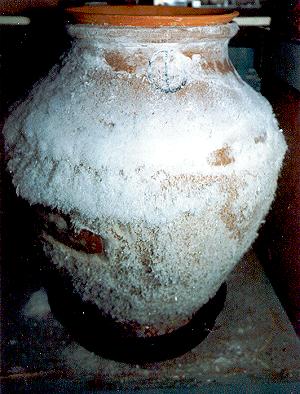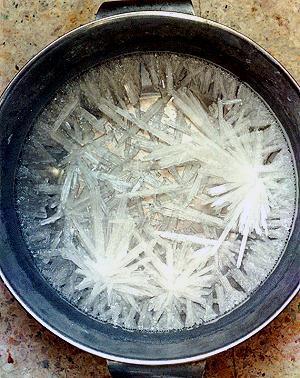Nitre
The nitre or Dragon is a potassium nitrate salt
formerly known as saltpeter. Saltpeter is composed of the names "Sal" or salt,
and "Petrae" or rock. Literally, salt of the rock.
The nitre is efflorescent on the surface of the
earth, in many parts of the Globe, as in Egypt, in India, China, Persia, Ceylon, etc.
Some times it appears covering the walls of some
natural open grotto in the calcareous rocks and on the old, damp, lower walls of
buildings, mainly of the structures where the animals go to rest, as, for instance, the
stables and the corrals.
At present, it will be very difficult and nearly
impossible to get it where it originates in its natural environment.
There is, however, a method of preparing the
commercial nitre that is revivified in the natural environment where it originates.
As incredible as it seems, it is daily within
your reach. And although it may be repulsive to you, there is no other alternative that
can be used to prepare it.
Arrange a provision of, at least, 10 litres of
the liquid excretion of ruminant animals or of yourself and pour it into large plastic 5
litre bottles. Let it putrefy what you will notice the nauseous smell that exhales.
Acquired a pot of porous mud that it is not
glazed, that is, that it is porous, with the capacity of, at least, 15 litres. Place it in
a basement or in the attic, to shelter it from direct solar light.
Pour into 10 litres of the putrefied organic
liquid, little by little, 4kg of the commercial nitre, stirring very well with a wood
stick, to dissolve the salt the best possible. Place on top, a mud cover and, underneath,
a plastic plate, in order to receive the liquid that will eventually drain.
After some days, the salt will begin to flow,
because of the porosity, in the external part of the pot, in the form of a layer of fluff,
very fine, that is going to grow, as you can observe in the picture.
When you observe that the amount of salt is
enough and it tends to come off of the wall of the pot; remove it with a brush, or with a
wooden spatula, taking care of not loosening the mud crusts that eventually come off of
the wall of the pot.
When you have about 1kg of salt, place it in a
recipient of stainless steel, as for instance, a big porringer, and pour into it enough
cold rainwater to dissolve it completely.
After all is dissolved, filter through a big
funnel of plastic, with a cotton filter, into a large plastic 5 litre bottle.
Pour the liquid filtrate into the recipient of a
stainless still and place it on a gas stove, taking care of not letting the temperature to
go up above the 60 degrees.
When the liquid is reduced to a third,
approximately, turn off the fire and place the recipient to rest one night, in a fresh
place. The following day, you will find in the recipient the salt crystallised in
agglomerates of great needles, very beautiful of seeing, as you can observe in the
respective picture.
Remove the salt with a spoon and I repeated the
same process, until you have extracted all the salt.
It is very probable that, in the first
crystallisation, the salt is not completely pure and white therefore, dissolve it in
rainwater again and I repeated the process, until your salt is white and transparent.
Remove and dry it to the shade, in a white cloth of very clean cotton.
In certain operations, as in the distillations of
spirits, you can use another potassium salt that, probably, it will be easier for you to
get, originating from your natural environment. It is the sodium nitrate originating from
Chile or Peru, which is used as natural fertiliser in agriculture. If you can get it
natural, all you will have to do is the purifying, dissolving it and crystallising it in
rainwater, just as you did with the nitre. But if you have any doubt with relationship to
its provenience and quality, it will be preferable for you to use the nitre revivified.
Nitre revivifyed:

Nitre crystallized:

Rubellus Petrinus